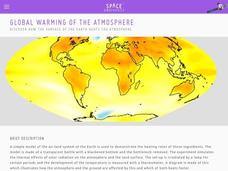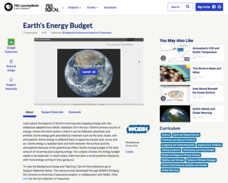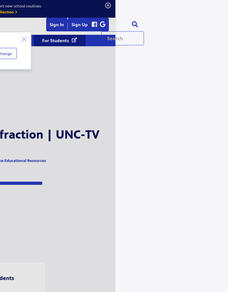Curated OER
Chromatography
Students use chromatography to separate substances in Kool-Aid, Crayola markers and leaves. In this chromatography lesson plan, students make chromatograms to separate substances in a mixture through absorption. Students find the Rf...
Curated OER
Radiation and Color
Tenth graders explore the relationship between color and heat absorption by measuring the temperature change of water in differently colored test tubes as they are exposed to a heat lamp. They work in small groups to collect data and...
Curated OER
The Science of Shadow Puppets
Learners explore the art of shadow puppetry. In this performing arts lesson plan, students study the functions of lighting in the puppet theater as they examine the transmission, absorption, and reflection of light. As a culminating...
Curated OER
Investigating Light
Students study concepts associated with light. In this light lesson, students observe an demonstration by the teacher. They examine reflection and refraction of light and name things that reflect light and those that refract it. They...
Teach Engineering
Thirsty for Gold
In the last portion of the six-part unit, teams perform an experiment with gold nanoparticles to determine which sport drink has the most electrolytes. The nanoparticles are used as chemical sensors and fluoresce in different wavelengths...
Teach Engineering
Water Remediation Lab
Water filtration — that's pure genius! Groups test the ability of a water filter to purify water by running chlorine contaminated water through a filter and measuring the chlorine concentrations as they filter the water. They then graph...
PHET
Molecules and Light
Does light affect molecules or does it go right through them? The simulation explores four different types of light: microwave, infrared, visible, and ultraviolet. Scholars alter the energy level of each as it is aimed at seven different...
Space Awareness
Global Warming of the Atmosphere
Scientists know the amount of carbon dioxide in the atmosphere today is higher than at any point in the last 800,000 years. Scholars learn about the amount of thermic radiation absorbed by air and what happens to the rest of the...
PBS
Earth’s Energy Budget
Is Earth's energy flow a little off balance? Explore our energy budget using a click-through interactive. Scholars discover the many factors that move solar energy around the planet and why the system is no longer in equilibrium.
Purdue University
Design of an Earthen Dam for a Lafayette Neighborhood
How do dams support bodies of water? Scholars engage in a hands-on STEM activity where they design, build, and test dams to learn about bodies of water and how humans use natural resources. They learn how criteria and constraints affect...
College Board
2013 AP® Biology Free-Response Questions
AP® free-response questions are often challenging for scholars. Give them practice writing free-response questions using former questions from the AP® Biology exam on topics such as genetic mutations, cellular respiration, evolution, and...
American Chemical Society
Designing an Absorbency Test
Time to soak up some learning! A hands-on lesson teaches learners about the absorbency properties of substances. They conduct tests by dipping different materials in water to determine which hold water and then complete a handout to...
PBS
Reflection and Refraction | UNC-TV Science
Uncover the exciting interactions of light energy and matter ranging from color to optical illusions. Participants explore color using red and green apples, differences between reflection and refraction, and descriptions of related...
Curated OER
Frozen Film
Students are introduced to the topic of light interference through this hands-on activity. They observe how light reflects off two surfaces and then meets to form an interesting variation of color on a film surface.
Curated OER
Using Models to Communicate
For this models worksheet, students read about how models are used to communicate events or principles in science. They are given an example and answer 4 questions about models. They discuss accuracy and inaccuracy of models. They create...
Curated OER
The Effects of Color on Heat Absorption And Climate
Students conduct an experiment to determine the effects of soil color on its day and night time temperatures. In small groups, they prepare dishes of black soil, brown peat moss, and white sand. They record the temperature changes when a...
Curated OER
Suck It Up
Pupils investigate the "wicking capacity " of fabric; that is how well various fabrics draw water "perspiration" away from the body and let it vent to the outside. They brainstorm possible protocols to measure, tabulate and analyze the...
Curated OER
How Does Light Interact With Matter?
In this light worksheet, students will brainstorm problems associated with the interaction of light with matter. Then students will write in possible solutions to those problems in this graphic organizer.
Curated OER
Generate a Calibration Curve for Chlorophyll a
Students measure and graph the absorbance of light by chlorophyll at a specific wavelength versus chlorophyll concentration. They are given an unknown and determine its concentration from their calibration curve. Students become familiar...
Curated OER
Stellar Fingerprints: the Spectra of Stars
Students explain how an element can be identified using emission spectra. They relate the emission spectrum of hydrogen to its absorption spectrum and identify hydrogen absorption lines in the spectrum of stars.
Curated OER
Obtain a visible spectra of chlorophyll a
Students become familiar with the concept of spectroscopy or the study of the interaction of matter with electromagnetic radiation. They prepare solutions and measure absorbance at different wavelengths. Pupils comprehend that mater and...
Curated OER
Here It Comes, There It Goes!
Pupils use an ordinary toy to reveal the Doppler effect. The connection is also made to moving cars, and to the shifting of the lines in the absorption or emission spectrum when the distance between a star and Earth is increasing or...
Curated OER
How Can We Calculate an Equilibrium Constant?
Students explain how equilibrium quantities are changed by temperature, pressure or different concentration of substances. They work together to complete equilibrium equations. They identify the relationship between absorption of light...
Curated OER
The Chemistry of Lead
Learners explore the basic concept of physical and chemical properties of the element lead, as well as its historical and modern day uses, and how and why it is toxic to the human body. They are shown the basic reactions of the element...

























